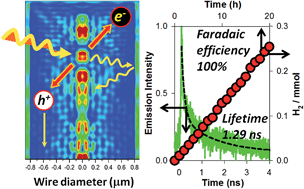Photoelectrochemical hydrogen production on silicon microwire arrays overlaid with ultrathin titanium nitride†
Abstract
p-Si wire arrays overlaid with an ultrathin titanium nitride (TiN) film are developed and demonstrated to be an efficient and robust photocathode for hydrogen production. Arrays of vertically aligned 20 μm long p-Si microwires of varying diameters (1.6–14.6 μm) are fabricated via a photolithographic technique, and then the wires are coated with a TiN nanolayer 2–20 nm thick by low-temperature plasma-enhanced atomic layer deposition. The optimized heterojunction consisting of 1.6 μm-thick wires covered by 10 nm thick TiN exhibits significantly improved performance for hydrogen evolution reaction under simulated sunlight (AM 1.5G, 100 mW cm−2). It displays a photocurrent onset potential of ∼+0.4 V vs. reversible hydrogen electrode (RHE), and a faradaic efficiency of nearly 100% at 0 V vs. RHE over 20 h of reaction. Time-resolved photoluminescence decay reveals that the lifetime (τ) of the photogenerated charge carriers in the optimized wire/TiN heterojunction is ∼60% shorter than those using thicker wires, suggesting significantly faster charge transfer. Such remarkable performance is attributed to enhanced transfer of the minority carriers in the radial direction of the wires. TiN performs the triple roles of antireflection, protection of the Si surface, and electrocatalysis of hydrogen production. Finite-difference time-domain simulation reveals a significant increase in the absorptance of wire arrays with TiN film, and that long wavelength photons are more effectively absorbed by the wire/TiN arrays.


 Please wait while we load your content...
Please wait while we load your content...